Physical Address
304 North Cardinal St.
Dorchester Center, MA 02124
The development of surgery on the extracranial cerebrovascular circulation was dependent on three principal factors: (1) recognition of the pathologic relationship between extracranial cerebrovascular disease and subsequent cerebral infarction, (2) the introduction of cerebral angiography to identify lesions before the patient's death, and (3) the development of vascular surgical techniques that could be applied to the extracranial vessels once the anatomic patterns of disease were understood and described.
The earliest report linking cervical carotid artery disease to stroke is credited to Savory, who in 1856 described a young woman with left monocular symptoms in combination with a right hemiplegia and dysesthesia. Postmortem examination demonstrated an occlusion of the cervical portion of the left internal carotid artery, along with bilateral subclavian artery occlusions. In 1875, Gowers reported a similar case, and subsequent reports of individual cases were made by Chiari in 1905, Guthrie and Mayou in 1908, and Cadwater in 1912. By 1914, in an important publication Hunt emphasized the relationship between extracranial carotid artery disease and stroke. He also described the phenomenon of intermittent cerebral symptoms associated with partial occlusion and used the term cerebral intermittent claudication as a characterizing analogy. Hunt also pointed out that the clinicopathologic observations in patients with stroke were hampered by the fact that routine autopsies did not include examination of the cervical carotid arteries (as is often the case today because of the desire to maintain access to the external carotid artery for the mortician). He emphasized that no examination of cerebral infarction can be considered complete without examination of the neck vessels.
The next major step in the evolution of the management of extracranial cerebrovascular disease came with the development of carotid angiography by Moniz in 1927. By 1937, Moniz and colleagues had described four cases of internal carotid occlusion diagnosed by angiography. In 1938, Chao and colleagues added two more cases, and by 1951, Johnson and Walker had collected from the world literature a total of 101 cases of occlusion of the cervical carotid artery diagnosed by angiography. Despite these early observations, the medical world was still slow to appreciate the relationship between extracranial cerebrovascular disease and cerebral symptoms, as emphasized by the fact that when cerebral angiography came into common use for neurologic diagnosis in the 1950s and 1960s, only the intracranial vessels were included on radiographs films. The area of the carotid bifurcation was seldom examined. By the late 1950s, patients with hemiplegia were still commonly receiving diagnoses of a middle cerebral artery thrombosis, without consideration of carotid bifurcation as a source of the problem.
The next major steps in the evolution of understanding came from reports by Fisher in 1951 and 1954. Fisher reemphasized the relationship between extracranial arterial occlusive disease and cerebral symptoms. He also pointed out that the lesion could be either total occlusion or stenosis. His most important observation, however, was that the disease was often localized to a short segment of the carotid artery, and he predicted that surgical correction might be possible if patients could be identified in the early stages of the clinical syndrome. Fisher stated, “It is even conceivable that some day vascular surgery will find a way to bypass the occluded portion of the artery during the period of ominous fleeting symptoms. Anastomosis of the external carotid artery or one of its branches with the internal carotid artery above the area of narrowing should be feasible.”
The surgical phase of understanding and managing extracranial cerebrovascular disease probably began in 1951, but it was not reported in the literature until 1955. This early report by Carrea and colleagues from Buenos Aires described their experience with the management of a patient with carotid artery stenosis. They resected the diseased internal carotid artery and performed an anastomosis between the external carotid artery and the distal internal carotid, as predicted earlier by Fisher. In 1953, Strully and coworkers attempted a thromboendarterectomy of a totally thrombosed internal carotid artery. This attempt was unsuccessful, but the authors suggested that thromboendarterectomy should be technically feasible before thrombosis occurred, as long as the internal carotid artery is patent distally. The first carotid endarterectomy (CEA) was probably performed by DeBakey and colleagues in an operation done on August 7, 1953, but it was not actually written up until 1959 and then reviewed in 1975. The report that was most important in calling the world's attention to the feasibility of carotid artery reconstruction came from Eastcott and associates. Their operation was performed on May 19, 1954, on a patient who was having hemispheric transient ischemic attacks (TIAs) with demonstrable disease at the carotid bifurcation; they used direct, end-to-end anastomosis between the common carotid artery and the internal carotid artery distal to the atherosclerotic lesion.
Although operations on the carotid artery were in the early phase of development, surgical attack was also considered feasible on occlusive lesions of the major arch vessels. In 1956, Davis and colleagues reported their experience with endarterectomy of the innominate artery performed on a patient on March 20, 1954. In 1957, Warren and Triedman reported the second case.
By this time, the stage was set for the explosive development of an aggressive surgical approach to managing extracranial cerebrovascular disease as a means of preventing or treating cerebral infarction.
Thompson, in his 1996 Willis lecture, related in great detail the history of surgery to prevent stroke. Those interested in the definitive history will be rewarded by reading this excellent paper.
Therapy aimed at the prevention of cerebral infarction must be compared with the natural history of the disease process. The prognosis for a patient with extracranial arterial occlusive disease differs, depending on the presence or absence of symptoms. When a permanent neurologic deficit is present, the outlook worsens, thus underscoring the importance of prevention. A thorough understanding of the natural history of the disease is essential to formulating a rational and effective therapeutic program. The physician needs to be familiar with the expected results of each available option. This implies that no single alternative is applicable to all situations and that individualization is the key to effective prevention.
In the United States, approximately 600,000 people suffer a first stroke each year. In 200,000 of these cases, death follows, but at any one time approximately 1 million stroke victims are alive and disabled. In 1976, the annual direct and indirect cost of stroke was estimated at $7,363,784,000. Nearly 40 years later, with inflation and the accelerating cost of medical care, this cost has probably quadrupled. The incalculable morbidity of the affected individual adds further to the magnitude of this problem. Prevention remains the most plausible alternative.
The initial mortality of an ischemic stroke ranges from 15% to 33%. Survivors remain at an inordinately high risk of subsequent stroke, estimated between 4.8% and 20% per year. This implies that half of patients will experience a second event within 5 years. The average recurrent stroke rate reported in the literature is between 6% and 12% each year. The most common cause of death in patients with extracranial arterial occlusive disease is myocardial infarction (MI). However, in an analysis of 535 stroke victims, the leading cause of death was recurrent stroke, as opposed to the expected myocardial mortality.
Since 1973, public health statistics have documented an accelerating decline in stroke mortality. Stroke used to be considered the third leading cause of death in the United States. The American Heart and Stroke Association recently reported that stroke has now dropped to the fourth leading cause of death. The reasons for this are multifactorial but include successful efforts at primary prevention, including surgical intervention and treatment of carotid bifurcation lesions, improved medical management, and better care for the patient with acute stroke, often in specialized centers. This reduction in stroke mortality has led to the erroneous assumption that a decline has also occurred in stroke incidence, which may not be the case.
In 1989, Wolf and colleagues reported the epidemiologic data from the Framingham Study to the 14th International Joint Conference on Stroke and Cerebral Circulation. They reviewed the experience from three successive decades, beginning in 1953. A decline in stroke fatality in both men and women was observed. However, the 10-year prevalence of stroke actually rose, and the incidence of stroke in men rose from 5.7% to 7.6% to 7.9%, without any apparent change in women. The authors postulated that falling case fatality rates might have resulted from changes in diagnostic criteria, a lessening in stroke severity, or improved care of stroke patients.
Harmsen and colleagues reviewed the stroke incidence and fatality in Gothenburg, Sweden, between 1971 and 1987. They noted that the stroke incidence remained the same during that interval, but the stroke fatality rate declined in both sexes. This was more marked for intracerebral hemorrhage and subarachnoid hemorrhage than for infarction. They concluded that the decline in stroke fatality rates might have been related to a decrease in smoking or better management of blood pressure. They could not explain why no corresponding decline in stroke incidence occurred.
Moden and Wagener examined the epidemiologic aspects of stroke based on death certificate information available from the National Center for Health Statistics' compressed mortality file for all 50 states and the District of Columbia for the period 1968 to 1988. They noted a decline in stroke mortality that continued through the 1970s and 1980s, whereas morbidity remained constant and possibly even increased. They noted similar morbidity and mortality rates in both sexes. They concluded that the observed decrease in stroke mortality rates resulted from improved survival rather than a decline in incidence.
Krishnamurthi and colleagues reviewed the MEDLINE database to determine the incidence of new ischemic and hemorrhagic strokes between various regions over time. They included 119 studies (58 from high-income countries and 61 from low- and middle-income countries) and found that worldwide the incidence of stroke increased significantly between 1990 and 2010. However, the incidence of ischemic stroke in high-income countries reduced significantly by 13% and mortality by 37%. A variety of reasons for the decline in stroke mortality have been postulated, including the more aggressive treatment of hypertension and the use of specialized stroke intensive care units ( Fig. 19.1 ).
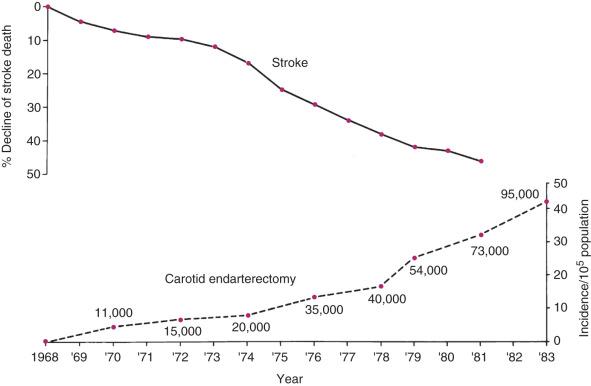
Two clinical syndromes deserve special emphasis because of their dismal natural history. Stroke in evolution is also known as progressing stroke or incomplete stroke ; it is an acute neurologic deficit of modest degree that within hours or days progresses to a major cerebral infarct. This can happen in a sequential series of acute exacerbations or in a pattern of waxing and waning signs and symptoms over hours or days, with incomplete recovery eventually leading to a major fixed neurologic deficit. Crescendo TIAs is the pattern that allows complete recovery between ischemic events, suggesting repeated frequent embolization from a point arterial source in the affected territory.
In a review of the literature, Mentzer and colleagues identified 263 reported cases of stroke in evolution managed conservatively. Twenty-three percent had complete resolution or mild neurologic deficit on follow-up. Sixty-two percent had a moderate to severe deficit in the early recovery phase. The overall mortality was 14.5%. In their own series, 26 patients with stroke in evolution were treated conservatively. Mortality was 15%, but more importantly, 66% suffered moderate to severe permanent neurologic deficits, with only five patients recovering completely or experiencing only mild neurologic dysfunction. These results are compared with a series of 17 patients operated on emergently for stroke in evolution. None of these patients had worsening of the preoperative neurologic deficit, four (24%) remained unchanged, and 12 (70%) had complete recovery.
In 1972, Millikan reviewed the natural history of patients with progressing stroke. Of 204 patients, 12% were normal at 14 days, 7% had developed moderate to severe neurologic deficits, and 14% had died. Thus stroke in evolution treated conservatively carries a poor prognosis. More than half of patients develop a severe permanent neurologic deficit within a few days of the onset, and approximately 15% die as a result. Only 10% to 20% recover full or partial neurologic function.
Patients who experience TIAs are also at a higher risk of developing a stroke. In the Mayo Clinic population study, 118 patients with TIAs were monitored as a control group without therapy. The stroke rates at 1, 3, and 5 years were 23%, 37%, and 45%, respectively. Most permanent deficits occurred during the first year. This represents a 16-fold increased risk of stroke compared with an age- and sex-adjusted population. The Oxfordshire project reported an actuarial risk of stroke during the first year after the onset of TIAs to be 11% to 16%. For each subsequent year, the rate was 5% to 9% per year. Some series have reported lower figures, but the average reported in the literature is on the order of 30% to 35% at 5 years, or 10% the first year and 6% each year thereafter.
Finally, Toole noted that cerebral infarction in TIA patients goes unrecognized by either patient or physician surprisingly often. These lesions are now identified by better neuroimaging techniques, and there is now evidence to suggest that TIAs are actually small strokes. If TIAs are actually small strokes, the implied benignity of TIAs must be reexamined, and it may be equally important to prevent TIAs. This consideration is further strengthened by the observations of Grigg and colleagues, who correlated cerebral infarction and atrophy as a function of TIAs and percentage of stenosis. They graded carotid stenosis in symptomatic patients from A (no stenosis) to E (occlusion). In patients with amaurosis fugax, the incidence of cerebral infarction rose from 2% in patients with stenosis grades A, B, and C to 40% in grade D and 58% in grade E. The incidence of atrophy increased in parallel, from 10% in grade A to 30% in grade E.
The natural history of asymptomatic patients with significant extracranial or arterial occlusive disease is difficult to predict accurately. Most studies that have addressed this problem used the presence of a cervical bruit as the sole criterion for inclusion. This inevitably includes patients without significant occlusive disease and omits others without cervical bruit but with high-risk lesions in the extracranial circulation.
As noninvasive studies developed, the detection of hemodynamically significant lesions in the carotid system improved. Kartchner and McRae monitored 1130 patients who either were asymptomatic or had nonhemispheric symptoms. The mean interval was 24 months. Of 303 patients with hemodynamically significant lesions, 11.9% had strokes at 2 years. The group with negative noninvasive studies had a much lower stroke rate, on the order of 3% over the same follow-up period. Busuttil and colleagues noted an unfavorable trend toward higher stroke rates in asymptomatic patients with hemodynamically significant lesions in the carotid bifurcation.
In a report by Roederer and colleagues, 167 asymptomatic patients with cervical bruits were monitored with serial duplex scanning, regardless of the degree of stenosis at the time of presentation. During follow-up, 10 patients became symptomatic. The development of symptoms was accompanied by disease progression in 80% of patients. By life-table analysis, the annual rate of symptom occurrence was 4%; however, the presence of progression graded at 80% stenosis was highly correlated with the development of either total occlusion of the internal carotid artery or new symptoms. Thus 89% of the symptoms were preceded by progression of the lesion to greater than 80% stenosis. Progression of a lesion to more than 80% stenosis was an important warning sign, because it carried a 35% risk of ischemic symptoms or internal carotid occlusion within 6 months and a 46% risk at 12 months. Conversely, only 1.5% of the lesions that remained at less than 80% stenosis developed such a complication. These data suggest that careful follow-up with repeated noninvasive evaluation is of great assistance in determining the appropriate management of asymptomatic carotid lesions.
In an analysis of 294 asymptomatic and nonhemispheric patients submitted to cerebrovascular testing, Moore and colleagues found a 15% stroke incidence during the first 2 years in patients with greater than 50% stenosis. In contrast, there was a 3% stroke incidence at 2 years in patients with 1% to 49% stenosis. The difference was found to be statistically significant ( P < .05). The 5-year cumulative stroke incidence was 21% with greater than 50% stenosis, 14% with 1% to 49% stenosis, and 9% in patients with no noninvasive evidence of carotid artery disease.
Chambers and Norris monitored a group of 500 asymptomatic patients with noninvasive studies and clinical evaluation. They identified two high-risk groups: those with stenosis greater than 75%, and those who showed disease progression between studies. For patients with greater than 75% stenosis, the 1-year neurologic event rate (TIA and stroke) was 22%. The 1-year stroke rate alone was 5%. In a later publication, the authors continued to note that neurologic events correlated with an increasing percentage of stenosis as well as disease progression between test intervals. In the study viewed over 5 years, the annual average neurologic event rate was 10% to 15%, with the highest event rate occurring within the first year of diagnosis. Finally, the incidence of silent cerebral infarction as documented by computed tomography (CT) was studied in the same patient population. The authors noted a 10% incidence of cerebral infarction among patients with mild (35% to 50%) stenosis, 17% with moderate (50% to 75%) stenosis, and 30% in patients with severe (>75%) stenosis. The authors concluded that silent cerebral infarction might be an indication for CEA in asymptomatic patients.
Although the natural history of asymptomatic carotid stenosis remains controversial, studies using serial noninvasive cerebrovascular testing have concluded that an increased risk of stroke exists ipsilateral to a 50% or greater carotid artery stenosis. These lesions appear to carry a risk of subsequent stroke on the order of 4% per year. In addition, progression of the disease carries an even higher risk of stroke, with lesions causing greater than 80% stenosis carrying a 35% risk of subsequent symptoms or carotid occlusion at 2 years.
Other studies have suggested that the composition of the plaque influences the stroke risk of carotid artery lesions. In one analysis, 297 patients with carotid stenosis greater than 75% at the time of initial study were at higher risk than peers without significant narrowing or development of symptoms ipsilateral to the lesion. Even those patients with less than 75% stenosis were at greater risk if the associated plaque was less organized (i.e., soft). This was determined by B-mode ultrasonography, which was used to classify plaques as dense, calcified, or soft. A definite trend toward higher risk was seen in plaques of lower density. Only 10% of those patients with calcified plaque in significantly stenotic vessels developed symptoms, whereas 92% of patients with soft plaques and tight stenosis developed symptoms within the first 3 years of follow-up. The morphology of the atherosclerotic plaque, as documented by B-mode ultrasonography, is emerging as one of the more important factors associated with embolic potential and stroke risk. Two studies have concluded that a heterogeneous plaque carries an increased risk of stroke and is a variable independent from carotid stenosis alone.
More recently, attempts have been made to better characterize the asymptomatic patient who is at higher risk for a cerebral ischemic event in order to identify subgroups of patients who would benefit from CEA compared with patients with carotid stenosis, who are at low risk for an ischemic event. In addition to percent stenosis and plaque composition, two factors have been identified as being associated with increased stroke risk in the asymptomatic patient. These factors include the presence of silent brain infarction, as seen on a screening CT scan, and silent brain embolic signals, as documented using transcranial Doppler. Kakkos and colleagues studied 821 patients with CT scans. In patients with 60% to 99% stenosis and without silent brain infarction on CT, the annual rate of TIA and stroke was 1.3%. In patients with silent brain infarction, the annual event rate was 4.4%, suggesting that this subgroup of patients might benefit from CEA, leaving the low-risk group free from an unnecessary intervention. Markus and colleagues evaluated 467 asymptomatic patients with high-grade carotid stenosis in a multicenter study. Transcranial Doppler identified 77 patients with embolic signals. The annual risk of TIA and stroke was 7.13% in patients with embolic signals, compared with 3.04% in patients without embolic signals. For ipsilateral stroke alone, the hazard ratio was 6.37. These findings suggest that screening for silent brain emboli is another method for identifying a high-risk group that is more likely to benefit from intervention.
The embolic potential of ulcerated carotid lesions has been well documented. Patients who experience symptoms from these lesions probably have the same prognosis as patients with occlusive lesions. Whether the former patient group responds more favorably to platelet antiaggregants remains to be determined. Moore and coworkers first pointed out that asymptomatic patients with significant ulceration in a carotid plaque in the absence of stenosis appear to be at higher risk of stroke. In a subsequent report, they expanded their series to 153 patients with asymptomatic, nonstenotic ulcerative lesions in the carotid bifurcation. Patients with deep (grade B) or complex (grade C) ulcerations received follow-up and were found to have a stroke rate of 4.5% and 7.5% each year, respectively. Other reports have suggested a similar stroke risk for complex ulcerations in the carotid bulb. However, a much lower stroke risk was reported for deep (grade B) ulcerations, with no significant added risk of stroke observed in these patients. Controversy still exists about deep ulcerations without complex morphology. However, agreement exists that complex ulcerations in the carotid bulb increase the risk of stroke in asymptomatic patients.
The presence of an asymptomatic hemodynamically significant stenosis may increase the risk of stroke during major surgery. Kartchner and McRae reported their experience with 234 patients, 41 of whom had evidence of significant carotid artery stenosis by oculoplethysmography. Seven postoperative strokes developed in the group with positive criteria (17%), whereas postoperative cerebral infarction developed in 2 of 192 patients (1%) with negative noninvasive studies. The mechanisms of stroke and the territory involved were not specifically reported. This high incidence of permanent neurologic deficits led the authors to conclude that prophylactic CEA should be considered in patients with hemodynamically significant carotid stenosis who are undergoing a major cardiovascular procedure.
Other series have reported results to the contrary. Using noninvasive vascular evaluation and, in one series, angiography, patients with 50% or greater stenosis in the carotid bifurcation were compared with patients who had lesser degrees of stenosis undergoing cardiovascular surgery. No increased incidence of perioperative strokes was found in patients with positive criteria. Most of these investigators, however, excluded preocclusive stenosis in their considerations. Lesions causing 90% or greater stenosis were excluded from these series and were subjected to prophylactic endarterectomy before cardiovascular operation.
Cardiac surgeons have long been concerned about the presence of carotid stenosis in patients who will be undergoing cardiopulmonary bypass. Their concern is that during bypass there will be a decrease in pump perfusion pressure and a corresponding and unacceptable drop in cerebral blood flow. In fact, the opposite occurs. Von Reutern and colleagues used transcranial Doppler ultrasonography to study middle cerebral artery blood flow before and during cardiopulmonary bypass in patients with and without carotid artery disease. Surprisingly, middle cerebral artery blood flow actually increased during cardiopulmonary bypass. Although the increase was not as great in patients with carotid artery disease, it was clearly an increase over baseline. This observation should dispel concern about the potential drop in cerebral blood flow in patients with carotid stenosis while using the pump.
Patients with a combination of severe carotid stenosis and symptomatic coronary artery disease represent a cohort that is at high risk of death, MI, and stroke. Brener and colleagues performed an extensive literature review that examined complications associated with different treatment strategies. Patients who underwent staging with CEA first had a high cardiac morbidity and mortality. Patients who had coronary bypass first had higher stroke morbidity. The data suggested that combined or simultaneous coronary artery bypass grafting and CEA might reduce overall morbidity and mortality. However, evidence from retrospective reviews was not sufficiently compelling to make a definitive recommendation. Consensus exists that this is an appropriate topic for a prospective, randomized trial.
The natural history of extracranial arterial occlusive disease cannot be complete without a consideration of the natural history of frequently associated conditions such as coronary artery disease, hypertension, and diabetes. MI remains the most frequent cause of death in these patients. Including these variables in the equation when one is formulating a treatment plan for a particular patient is therefore important. The goal of therapy should be the prevention of a permanent neurologic deficit. When deciding on the most effective way to achieve this, one must consider the life expectancy of the patient and the inherent risk of each particular form of therapy.
The pathology of cerebrovascular disease of extracranial origin can be divided into flow-restrictive lesions and lesions with embolic potential. Each of these can be further subdivided into occlusive and aneurysmal lesions. All entities that have been described as etiologic in extracranial disease fall within these categories.
By far the most common lesion found in patients with extracranial cerebrovascular disease is an atherosclerotic plaque in the carotid bifurcation. This can produce symptoms by reducing blood flow to the hemisphere supplied or, more commonly, by releasing embolic material. Emboli can be composed of clot, platelet aggregates, or cholesterol debris.
The carotid bifurcation appears to be susceptible to the development of atherosclerotic plaques. Frequently, severe changes at the carotid bifurcation occur with minimal or no changes present in the common or internal carotid artery. Several investigators have proposed conflicting theories based on hemodynamic observations in various models. High and low shear stress and fluctuations in shear stress, disordered or turbulent flow, flow separation, and high and low flow velocity have all been implicated. It is unknown which of these mechanisms is responsible for plaque formation. Zarins and colleagues used a model of the human carotid bifurcation under steady flow and compared its hemodynamics with those of cadaver specimens. They concluded that carotid lesions localize in regions of low flow velocity and flow separation, rather than in regions of high velocity and increased shear stress. They used their model to explain the propensity of the outer wall of the carotid sinus opposite the flow divider to develop atherosclerotic plaques ( Fig. 19.2 ). This may have further clinical implications, in that an enlarged carotid bulb after endarterectomy may create a region of reduced flow velocity and increased boundary layer separation, which may favor recurrent plaque deposition.
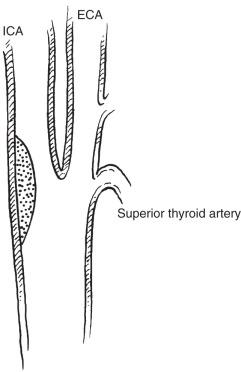
Once the initial intimal injury is produced by these forces, platelet deposition, smooth muscle cell proliferation, and the slow accumulation of lipoproteins are involved in the reparative process ( Fig. 19.3 ). These eventually lead to plaque formation, which further alters the hemodynamics of the system and favors further injury.
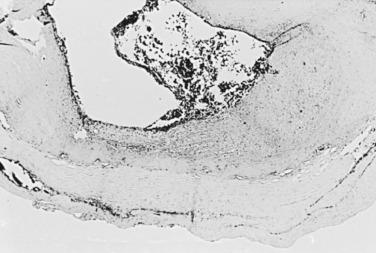
The contribution of platelets to atheroma development can take several forms. Platelets may adhere to one another, to the diseased vessel, or both; this can lead to thrombus formation. This process may narrow the vessel lumen, or the thrombus may dislodge, resulting in distal embolization. Vasoactive substances stored in granules within the platelet may be released, causing vasospasm and also contributing to compromise of the arterial lumen. The platelets' interaction with collagen exposed in an injured intima may include elaboration of a smooth muscle growth factor that can lead to intimal thickening. The activation of enzymes in platelets, by their contact with collagen, initiates the production of highly active prostaglandins. The production of thromboxane A 2 represents the final common pathway of platelet response to diverse stimuli. This substance is a potent stimulant of platelet aggregation and a powerful vasoconstrictor, and is believed to be important in the pathophysiology of plaque formation or the development of symptoms from an already established atheroma.
Hemorrhage into a plaque may also play a significant role in the development of symptoms from an atherosclerotic lesion. Imbalances in wall tension secondary to asymmetrical deposition of plaque can lead to sudden plaque fracture and intraplaque hemorrhage. These can lead to the sudden expansion of the atheroma, with acute restriction of flow or breakdown of the intimal surface and concomitant embolization. An alternative mechanism for sudden intraplaque hemorrhage may be related to an increase in neovascularity within the plaque substance. Hypertension may be responsible for precipitating the rupture of neovascular vessels, leading to intraplaque hemorrhage and expansion. This process may be responsible for a large number of symptomatic lesions. In a prospective evaluation of 79 atheromatous plaques removed from 69 patients undergoing CEA, 49 of 53 (92.5%) symptomatic patients had evidence of intramural hemorrhage. In contrast, only 7 of 26 (27%) asymptomatic patients showed recent or acute intraplaque hemorrhage. Rupture of an atherosclerotic plaque with intraluminal release of atheromatous debris has also been correlated with acute stroke and internal carotid occlusion in an autopsy study.
Fibromuscular dysplasia is a nonatherosclerotic process that affects medium-size arteries. It was first described in the carotid artery in 1964, and since then it has been recognized as a cause of cerebrovascular symptoms. It may also affect the intracranial arteries, and approximately 30% of patients with cervical involvement have associated intracranial aneurysms. Up to 65% of patients have bilateral disease, and 25% have associated atherosclerotic changes.
Four histologic types of fibromuscular dysplasia have been described :
Intimal fibroplasia accounts for about 5% of cases and affects both sexes equally. It usually appears as long tubular stenoses in young patients and as focal stenoses in older patients. It results from an accumulation of irregularly arranged subendothelial mesenchymal cells with a loose matrix of connective tissue. Medial and adventitial structures are always normal.
Medial hyperplasia is a rare form of the disease that produces focal stenoses. The intima and adventitia remain normal, whereas the media shows excess smooth muscle.
Medial fibroplasia is the most common pattern of fibromuscular dysplasia, accounting for most, if not all, internal carotid artery involvement. It may appear as a focal stenosis or multiple lesions with intervening aneurysmal outpouchings. Histologically, the disease is limited to the media, with replacement of smooth muscle by compact fibrous connective tissue. The inner media may show an accumulation of collagen and ground substance separating disorganized smooth muscle cells. Gradation of these changes correlates with the severity of the lesion. Mural dilatations and microaneurysms are common.
Perimedial dysplasia is characterized by the accumulation of elastic tissue between the media and adventitia. It affects renal arteries and is associated with macro-aneurysms.
Fibromuscular dysplasia preferentially affects long arteries with few primary branches. Hormonal effects on medial tissue, mechanical stresses on the vessel wall, and unusual distribution of the vasa vasorum in these arteries seem to play a causative role. Some experimental evidence and the fact that women are most commonly affected (92% of cases) support a possible role of hormones in this process. In the appropriate hormonal environment, the normal paucity of vasa vasorum in long, nonbranching arterial segments such as the extracranial carotid artery and the renal artery may predispose to mural ischemia and initiation of the fibroplastic process. Experimental evidence supports this concept.
The exact cause of symptoms is controversial. Thromboembolism from clot, platelets, or both; decreased flow owing to a critical stenosis or a series of noncritical narrowing; intracranial involvement, with or without aneurysm formation; and hypertension have been implicated.
Coils and kinks of the extracranial system on occasion have been associated with fibromuscular dysplasia. More commonly, these are due to embryologic events and changes that occur in the aging process. Most coils are asymptomatic, although neurologic manifestations from these anomalies have been reported in children and in adults. Embryologically, the internal carotid artery is derived from the third aortic arch and the dorsal aortic root. In the early stages of development, a normally occurring kink is straightened as the heart and great vessels descend in the mediastinum. Failure of this process may account for the occurrence of coils and loops in children and for its bilaterality in approximately 50% of cases.
In adults, kinking of the extracranial vessels is almost always associated with atherosclerosis. In the aging process, loss of elasticity of the vessel wall occurs, which, in combination with lateral stresses, causes elongation between fixed points—the skull and the thoracic inlet. This produces bowing, with the eventual formation of coils and kinks. Between 5% and 16% of patients submitted for angiographic evaluation have coiling or kinking of one of the extracranial vessels. Kinking of the artery is more likely to produce symptoms because of either flow reduction or concomitant plaque formation with distal embolization. Kinking is considered to be an angle of less than 90 degrees between arterial segments ( Fig. 19.4 ). Flow restriction is unlikely to exist in the absence of this configuration. This acute angulation is more likely to occur when the head is turned to the ipsilateral side. In other cases, contralateral rotation, neck flexion, and extension may exaggerate the abnormality, leading to markedly reduced flow. A history of TIAs associated with head motion should lead the clinician to suspect the presence of a kink. Abnormal pulsations in the neck, sometimes suggesting an aneurysmal dilatation, may be present on physical examination. Secondary arteriosclerotic changes can occur because of abnormal flow patterns that predispose to plaque formation and ulceration, accounting for the development of neurologic symptoms. Rarely is the vertebral circulation affected by a kink.
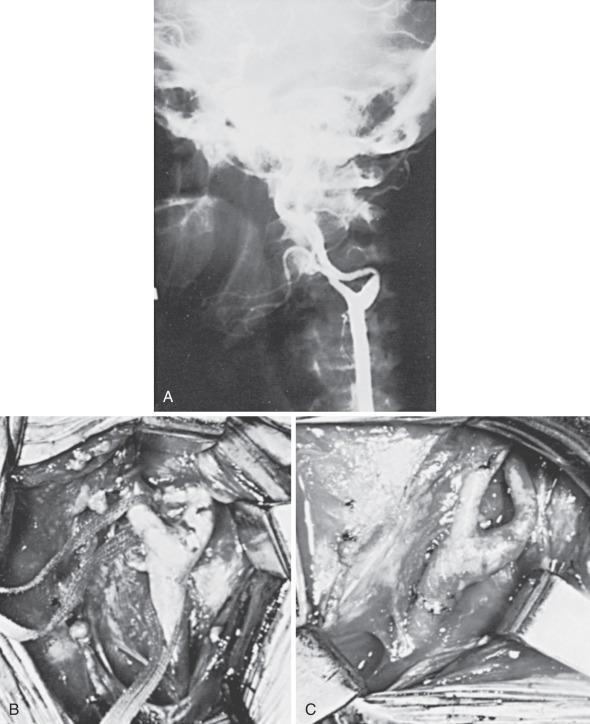
Aneurysms of the carotid artery can cause neurologic symptoms by several mechanisms. Thrombosis and rupture are rare, but embolization is a frequent event. Pressure on cranial nerves can be seen when expansion is rapid, but more frequently this is associated with acute dissection.
Most extracranial aneurysms are secondary to atherosclerosis. Internal elastic lamina disruption and medial thinning are frequent histologic findings. Two types of aneurysms are recognized: fusiform and saccular. Fusiform aneurysms are more common; they are frequently bilateral and are associated with other arterial aneurysms. Saccular aneurysms are often unilateral and tend to involve the common or internal carotid arteries more often. They may also have a congenital, degenerative, or traumatic origin. Atherosclerotic aneurysms of the extracranial circulation are almost always associated with hypertension.
Trauma is a frequent cause of carotid aneurysms. These are usually saccular and most commonly result from blunt rather than penetrating injury. Hyperextension and rotation of the neck cause compression of the internal carotid artery on the transverse process of the atlas. An intimal injury is produced that frequently leads to thrombosis, but it can also produce aneurysmal dilatation.
Mycotic aneurysms are rare. Syphilis and peritonsillar abscess were once common causes of these aneurysms. Staphylococcus aureus is currently the predominant responsible organism.
False aneurysms of the carotid artery may form after penetrating injury, but the most frequent cause is previous carotid surgery. These aneurysms are more common after patch closure of the artery than after primary closure. Disruption of the suture line by infection, suture failure, and technical error are believed to be responsible for their formation. False aneurysms can expand, thrombose, rupture, or lead to distal embolization. The diagnosis of false aneurysm is an indication for surgical or endovascular repair, depending on the location, the presence of intraluminal thrombus, and the experience of the surgeon.
Acute dissection of the carotid artery with or without aneurysm formation is another cause of neurologic events resulting from abnormalities in the extracranial circulation. It can occur secondary to atherosclerosis, fibromuscular dysplasia, or cystic medial necrosis. A history of trauma may or may not be present. On gross inspection, a sharply demarcated transition between the normal color and size of the carotid artery and the dark blue, cylindrical dilatation in the dissected segment is noted. More commonly, the internal carotid artery is affected, and frequently the end of the dissection is not surgically accessible. A double lumen is usually present, with the dissection occurring in the outer layers of the media. Smooth muscle cells are widely separated, and degeneration and fragmentation of the internal elastic membrane occur. The most frequent presentation is a sudden onset of temporal headache or cervical pain associated with a neurologic or visual deficit or Horner syndrome. Acute expansion may cause compression of cranial nerves IX, X, XI, or XII, with concomitant dysfunction. Horner syndrome is thought to be secondary to the disruption of periadventitial sympathetic fibers. The carotid artery is far more frequently affected than the vertebral artery is. Only a few cases of the latter have been reported, with involvement of the segment between C1 and C2 noted consistently.
In 1908, Takayasu described ocular changes in a 21-year-old woman with nonspecific arteritis. These changes consisted of a peculiar capillary flush, with rustlike arteriovenous anastomoses around the papilla and blindness owing to cataracts. Similar cases were later described with the absence of pulses in the arm. Since then, Takayasu arteritis has been recognized as a cause of neurologic symptoms secondary to a nonspecific inflammatory process of unknown cause, segmentally affecting the aorta and its main branches. The end result of this process is constriction or occlusion of, and occasional aneurysm formation in, the affected vessels secondary to marked fibrosis and thickening of the arterial wall. Originally thought to be rare in the Western hemisphere, many cases of atypical coarctations of the aorta and other unusual lesions of its main branches are now well recognized as Takayasu arteritis. This explains the many eponyms given to this syndrome.
Four varieties of the disease are recognized. In type 1, involvement is localized to the aortic arch and its branches. Type 2 does not have arch involvement; the lesions are confined to the descending and abdominal aorta. Type 3 has features of both, and type 4 describes any of the first three types, plus involvement of the pulmonary artery. In a retrospective study of 107 patients, 84% were female, and 80% were aged 11 to 30 years.
Two phases of the disease are recognized. In the acute or prepulseless stage, systemic symptoms of a nonspecific nature are present. Skin rash, fever, myalgia, arthralgia, pleuritis, generalized weakness, and other nonspecific symptoms develop, making the diagnosis difficult. These symptoms may resolve and go unrecognized by the patient or physician until months or years later, when the second, or occlusive, stage evolves. Next, symptoms of obstruction of the main aortic branches develop. These lesions are not easily managed by endarterectomy, which makes bypass surgery the treatment of choice.
Other forms of arteritis, specifically giant cell arteritis, can cause neurologic symptoms because of extracranial or intracranial involvement. These patients are older than those with Takayasu arteritis, and both sexes appear to be equally affected. Systemic symptoms are usually present. Tenderness over the carotid artery or other affected areas may occur. The histologic picture is characteristic, with changes confined to the media, where a large number of giant cells interspersed with lymphocytes are seen. Early diagnosis is important, because corticosteroid therapy may abort the latter stages of the process.
External cervical radiation therapy is recognized as a cause of accelerated atherosclerotic changes in the extracranial circulation. Experimentally, atherosclerotic lesions similar to the naturally occurring ones can be produced in the abdominal aorta in dogs by x-ray and electron beam radiation. Injury to the endothelial cell, ground substance, elastic lamina, and smooth muscle appears to alter the vessel wall, increasing its permeability to circulating lipids and impairing its ability to repair elastic tissue, leading to the formation of a plaque characterized by fibrosis, fatty infiltration, and intimal destruction. These changes can occur months to years after the completion of therapy. Lesions occur in locations unusual for atherosclerosis ( Fig. 19.5 ). Blowout of the affected carotid artery may occur, but this is more frequent when surgery is combined with radiation in treating cervical malignancies. Hyperlipidemia and hypercholesterolemia appear to predispose patients receiving radiation therapy to the development of these accelerated changes. Endarterectomy of the affected segments is difficult but can be performed safely.
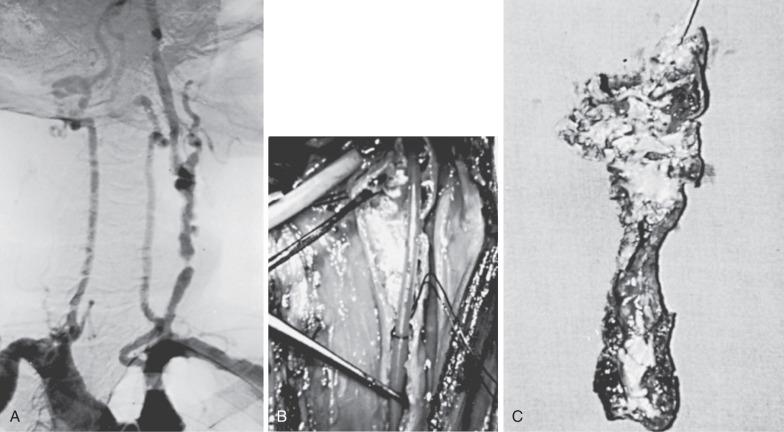
Moritz and colleagues reported their experience with 53 patients who had undergone radiation therapy to the neck an average of 28 months earlier and compared them with a control group of 38 patients who had not had radiation. Thirty percent of the radiated group had moderate to severe lesions of the carotid bifurcation, as detected by duplex scanning, in contrast to only 6% of the control group. Five patients in the radiated group were symptomatic. The authors concluded that patients who receive carotid radiation should undergo periodic follow-up duplex scanning of the carotid arteries.
Recurrent carotid stenosis has been reported to occur in 1% to 21% of cases and may yield an incidence of hemodynamically significant stenosis as high as 32% after 7 years. This can lead to neurologic symptoms by producing emboli or restricting flow. The most common lesion developing within the first 2 years after surgery is myointimal hyperplasia. Histologically, a concentric lesion occurs, with no calcium or lipid deposits. A dense accumulation of collagen and mucopolysaccharides surrounds cellular elements. These substances are produced by the myointimal cell in the normal healing process. Their accelerated production seems to be responsible for the development of the fibroplastic lesion leading to luminal stenosis. An endarterectomy plane is almost impossible to develop.
The morphologic characteristics of the early (<2 years) restenosis suggest a lower risk of stroke compared with arteriosclerotic lesions of a similar degree. In addition, regression of stenosis documented by noninvasive tests has been reported. Thus controversy exists over the management of early recurrent stenosis after CEA. In the asymptomatic stage, a restenosis documented by successive noninvasive testing should lead the surgeon to consider surgical intervention if progression to greater than 80% of the diameter occurs. Recurrent symptoms are certainly an indication for reoperation unless a different cause is suspected. Interestingly, Bernstein and colleagues showed an inverse correlation between greater than 50% recurrent stenosis and late stroke and death. Their data suggested that patients with early recurrent stenosis had a better long-term prognosis than those who did not develop recurrent stenosis.
When a stenotic lesion develops more than 2 years after CEA, atherosclerosis is usually the cause. Injury to the vessel by vascular clamps may play a role. Elevated serum cholesterol has a statistically significant association with recurrent carotid stenosis.
These lesions probably carry the same stroke risk as primary arteriosclerotic lesions in the carotid bifurcation. Recommendation for reoperation is thus based on the known risk factors of similar primary arteriosclerotic lesions.
Some investigators have shown that patch closure at the time of the initial CEA may prevent recurrent stenosis. Several prospective, randomized studies, either completed or in progress, suggest a lower incidence of restenosis with the use of patch angioplasty. The most compelling argument in favor of patch closure comes from a prospective study by AbuRahma and colleagues. The authors identified 74 patients with bilateral carotid stenoses in need of bilateral operation. One side was closed primarily, and the opposite side was closed with patch angioplasty. In this manner, demographic and patient characteristics were controlled. The incidence of ipsilateral stroke for primary closure was 4%, versus 0% for patch closure. In the primary closure group, there was a 22% incidence of recurrent stenosis, versus 1% in the patch group ( P < .003). There was an 8% incidence of internal carotid artery occlusion with primary closure, versus 0% with patch closure. Restenosis requiring reoperation occurred in 14% of the primary closure group and in 1% of the patch group. In a life-table analysis, the 24-month freedom from recurrence was 75% in the primary closure group, versus 98% in the patch group. A significant benefit of patch angioplasty appears to be a reduction in technical end point problems. Thus patching may be equally important in preventing occurrence and recurrence. The same objective can be achieved by preventing or correcting technical errors at the time of operation when they are identified by completion angiography. Data obtained from experimental hemodynamic studies suggest that an enlarged bulb following patch closure of an endarterectomy site may predispose to areas of low shear stress and therefore recurrent disease. For this reason, it is important not to over-enlarge the bulb when using a patch. Over-enlargement may be responsible for a higher incidence of recurrence after vein patch angioplasty (9%) versus prosthetic patch angioplasty (2%). However, both were superior to primary closure (34%) in a randomized study.
The benefit of patch closure was also seen in a retrospective analysis of other data from the Asymptomatic Carotid Atherosclerosis Study (ACAS). The study examined the incidence of recurrence for three time intervals: within 3 months of operation (residual disease), 3 to 18 months (myointimal hyperplasia), and 18 to 60 months (recurrent atherosclerosis). The use of patch angioplasty reduced the overall risk of restenosis from 21.2% to 7.1%. Factors associated with early recurrence include an incomplete intimectomy, the use of distal tacking sutures, female sex, continued cigarette smoking, and primary closure of an anatomically small internal carotid artery. A similar retrospective analysis was carried out using the CREST trial data base. CEA with patch was done in 755 patients and was compared with 328 patients with primary closure. There was a statistically significant reduction in periprocedural stroke, reoperation, the 4-year risk of stroke, and the 2-year risk of restenosis in favor of the patch closure group. Many clinicians routinely prescribe aspirin preoperatively as well as postoperatively, in the hope that embolic events from platelet aggregates can be reduced or eliminated. The rationale is that aspirin will reduce the incidence of myointimal hyperplasia by reducing platelet adhesion or aggregation and interfering with the platelet release reaction. Unfortunately, the carotid artery, like other areas subjected to arterial reconstruction, has not been shown to benefit. A prospective, randomized, placebo-controlled trial failed to show any benefit of aspirin in preventing early carotid restenosis.
In reviewing the mechanisms for TIA and cerebral infarction, emphasis is placed on those events related to disease in the extracranial vessels. Hemorrhagic stroke is excluded. Cerebral ischemic events related to hypertension and cardiac emboli are briefly reviewed because of their importance in the differential diagnosis and workup of symptomatic patients. Finally, from a pathogenetic standpoint, the difference between TIA and fixed deficit is a matter of degree, duration, and extent of actual infarction. The mechanisms of occurrence are essentially the same. Therefore, for purposes of discussion, we use the general inclusive term ischemic event .
When an atherosclerotic plaque expands to produce a critical reduction in blood flow, the vessel ultimately undergoes thrombosis. In the case of the internal carotid artery, if this column of thrombus stops at the ophthalmic artery and remains stable, and if collateral circulation is sufficient via the circle of Willis, the thrombotic event may be entirely asymptomatic ( Fig. 19.6 ). If the thrombus propagates beyond the ophthalmic artery to occlude the middle cerebral artery ( Fig. 19.7 ), or if small thrombi rather than a thrombotic column form and are subsequently carried to the intracranial vessels by continuous blood flow ( Fig. 19.8 ), the patient experiences cerebral symptoms that can vary from transient ocular or hemispheric events to a profound hemiplegia, depending on the extent of propagated thrombus or embolus . In addition, if the collateral circulation to the circle of Willis is poor, the sudden loss of flow through a diseased internal carotid artery may incite a precipitous drop in flow to the hemisphere, resulting in ischemic infarction as a consequence of inadequate proximal blood flow.
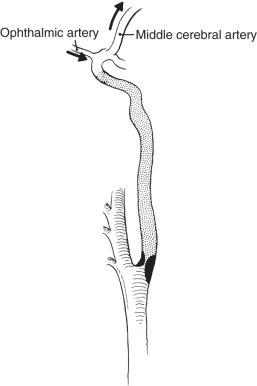
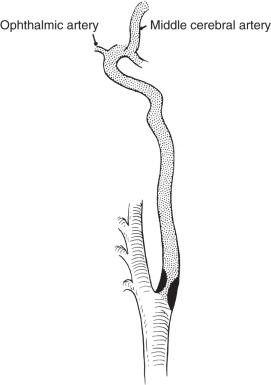
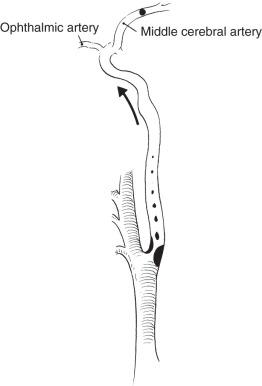
Although flow-related ischemia used to be considered the most common cause of transient ischemic events, it is actually a rather rare occurrence. Transient drops in hemispheric blood flow or the development of a chronic low-flow state can be responsible for nonspecific symptoms of lightheadedness, presyncope, or intellectual deterioration. It must also be recognized that other, nonvascular causes of these symptoms exist and are probably more frequent.
The collateral blood flow to the brain, via the circle of Willis, is an extremely efficient system. Multiple patients have been described who had bilateral internal carotid artery occlusion, perhaps combined with occlusion of the vertebral artery, but were totally asymptomatic from a central neurologic point of view. Experience obtained performing CEA under local anesthesia has shown that approximately 10% of patients experience neurologic symptoms when the carotid artery is clamped. This 10% may have symptoms on the basis of compromised blood flow when the stenosis progresses or goes on to complete occlusion. Another circumstance that can produce symptoms of global ischemia is simultaneous stenosis or occlusion in more than one extracranial vessel—for example, a carotid occlusion on one side combined with a high-grade stenosis in the contralateral carotid artery. Under these circumstances, transient drops in blood pressure, perhaps posturally related, can produce either global or focal ischemic symptoms. Rarely, patients with unilateral carotid occlusion may have a downstream vascular bed that is marginally perfused. Postural changes under these circumstances can also produce focal ischemia and result in a flow-related TIA. Under these conditions, a patient would be a good candidate for extracranial-to-intracranial bypass grafting.
Flow-restricting lesions in the vertebral arteries or in major vessels proximal to the vertebral origin, such as the innominate or subclavian artery, can produce symptoms related to hypoperfusion in the posterior circulation. One of the most dramatic anatomic observations is the so-called subclavian steal syndrome. If a stenosis or occlusion of the subclavian artery is present proximal to the vertebral artery takeoff, the pressure drop distal to the obstruction causes its branches to serve as sources of collateral blood flow by reversing the normal flow direction. The branches now contribute to the flow of the main trunk, rather than receiving flow from the proximally affected artery. The vessels that contribute to collateral blood flow of the distal subclavian artery by reversing flow include the vertebral artery. Under these circumstances, the vertebral artery not only is deprived of the usual antegrade flow but also actually siphons off blood flow from the basilar artery circulation because of flow reversal. This siphoning of blood may be entirely without symptoms if abundant sources of inflow from the other vertebral artery or from the anterior circulation exist. Conversely, if the opposite vertebral artery is small or occluded, a deficiency in basilar artery flow may be present that results in symptoms of basilar artery insufficiency. These symptoms may first appear or become exaggerated if the demand for flow in the affected subclavian artery increases, such as results from active exercise of the arm ( Fig. 19.9 ).
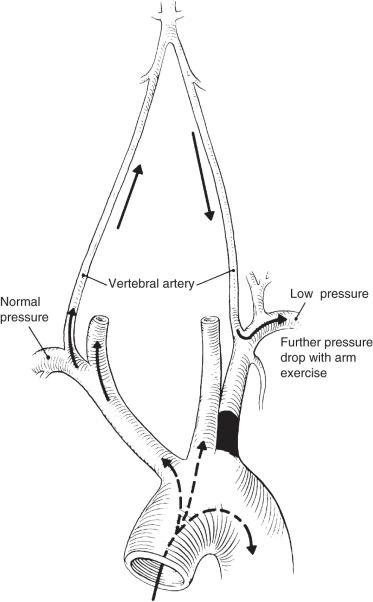
The most common causes of cerebral ischemic events are embolic phenomena, primarily arterial in origin and secondarily from cardiac sources. The emboli of arterial origin occur as a consequence of morphologic change present on the luminal surface of a critical artery. These changes most often are associated with atheromatous plaques but can also occur with other lesions such as fibromuscular dysplasia. When an irregular surface produces turbulence, a stimulus for platelet aggregation is present. If the platelet aggregates become large enough and embolize to an important vessel in the brain, symptoms occur. If the platelet aggregates break up quickly from mechanical forces or from the effect of arterial prostacyclin, the symptoms are transient. If the embolic fragment persists, however, it can lead to focal infarction ( Fig. 19.10 ).
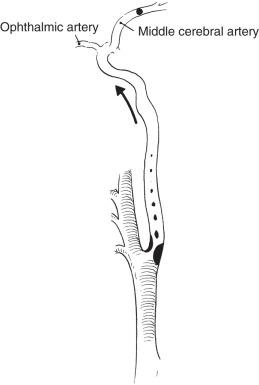
An atherosclerotic plaque may undergo central degeneration or softening. When this occurs, bleeding into the plaque substance can also occur, leading to sudden plaque expansion with intraluminal rupture, or the plaque may spontaneously rupture into the lumen, discharging its contents into the arterial stream. The plaque contents consist of degenerative atheromatous debris, including various mixtures of cholesterol crystals, calcific material, or thrombotic remnants. If the atherosclerotic plaque is located at a critical point, such as the origin of the internal carotid artery, considerable likelihood exists that embolic atheromatous fragments will be carried to important vascular beds of the brain, producing either transient or permanent neurologic events ( Fig. 19.11 ). These events are considered primary embolic events of atherosclerotic plaque origin.
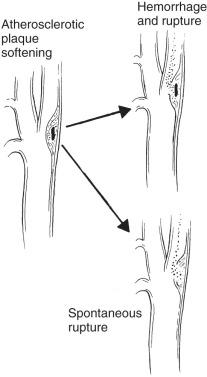
After the plaque has ruptured, a defect is left behind that is called an ulcer ( Fig. 19.12 ). Further primary emboli can continue to escape from the raw ulcerated surface, or the ulcer itself may serve as a focal point for thrombus or platelet aggregate material to form. These platelet or thrombotic aggregates may secondarily dislodge, owing to blood flow turbulence, and embolize to the brain ( Fig. 19.13 ). Thus the embolic material from an atherosclerotic plaque can consist of atheromatous debris, platelet aggregates, or blood clot. The emboli of arterial origin can be primary, occurring with plaque rupture or on thrombogenic arterial plaque surfaces, or secondary, having developed within ulcerative lesions from previous plaque rupture.

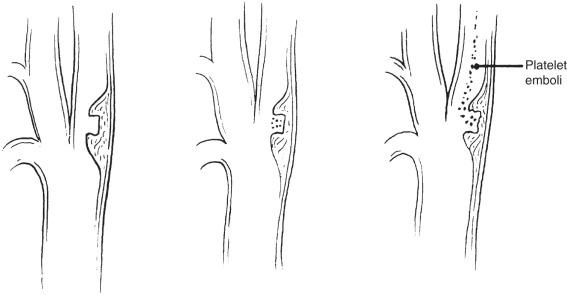
Embolic events may produce dramatic focal neurologic events that are immediately appreciated by the patient, or the embolic fragments may travel to more silent areas of the brain, in which case the results are more subtle and appreciated on a chronic basis, such as cerebral atrophy or multiple-infarct dementia. The use of transcranial Doppler ultrasonography has provided more objective evidence of emboli from carotid plaques by discerning discrete noise as an embolic particle passes a point of Doppler insonation. Finally, the occurrence of TIAs in a hemisphere distal to a carotid occlusion raises the question of the importance of decreased flow to arterial border zones. Experimental data have demonstrated that emboli originating from a contralateral carotid artery can cross through the circle of Willis and produce focal infarcts in the hemisphere distal to a carotid occlusion. Thus the contralateral patent carotid artery should always be considered a possible source of emboli when a patient with a carotid occlusion begins to experience symptoms in the hemisphere distal to the occlusion. The stump of an occluded internal carotid artery can also be a source of emboli. Flow to the external carotid artery can sweep platelet aggregate or clot residing in the stump of an occluded into carotid artery into a collateral branch such as the temporal or internal maxillary artery, which may be serving as a collateral to the carotid siphon via reversed flow through the ophthalmic artery.
Emboli can also occur from cardiac sources, which include aortic valvular disease, mitral valve prolapse, cardiac arrhythmias, and mural thrombus after MI. Venous thromboembolism passing through a patent foramen ovale, so-called paradoxical embolism, can also go to the brain. More recently, atherosclerotic plaques of the aortic arch, as seen with transesophageal echocardiography, have been identified as another source of cerebral embolization.
Focal areas of cerebral necrosis occurring in the basal ganglia, internal capsule, or pons have been described as a consequence of end-vessel occlusive disease involving the lenticulostriate or thalamoperforating arteries. The underlying cause is related to uncontrolled hypertension, and the resulting neurologic deficit is often clinically identified as a pure motor or pure sensory stroke. Although descriptions of this phenomenon date back to the early 1900s, current understanding is based on the efforts and writings of Fisher.
The clinical picture may often be confused with arterial-arterial emboli, in that antecedent TIAs may have occurred. The differential diagnosis is best made by the very focal neurologic deficit seen clinically and the typical anatomic location seen on the CT scan of the brain. Evidence shows that the so-called lacunae may also be the consequence of emboli of arterial origin. Thus symptoms and imaging of a deep white matter infarct do not rule out atheromatous plaque from the carotid bifurcation as a cause of the event.
Extracranial arterial occlusive disease can result in varying symptoms or be completely asymptomatic. A thorough history must be obtained, because this alone can provide clues to the specific nature of the event. Often one discovers the existence of symptoms that the patient has been ignoring. A complete review of symptoms is mandatory, because this may alter the therapeutic alternatives available. Risk factors for atherosclerosis should be specifically recorded.
Patients can be classified into three categories: asymptomatic patients, patients with TIAs, and patients with cerebral infarction. In asymptomatic patients, a hemodynamically significant lesion or a nonocclusive ulcerated arteriosclerotic plaque in the extracranial circulation may be discovered in the absence of transient or permanent neurologic symptoms. The presence or absence of a bruit in the cervical area should not be a criterion for inclusion in this category. It should be recorded as a general marker of a patient at high risk for atherosclerosis.
In an analysis of 1287 patients with cervical bruits, less than one-third of the carotid lesions with bruits proved to be hemodynamically significant by noninvasive criteria. The fact that significant lesions can occur in the absence of a bruit and vice versa is important. The available data on the natural history of asymptomatic bruits cannot be applied to patients with these lesions. This group of patients is usually discovered by angiography while studying other conditions or by noninvasive studies carried out because of the presence of a bruit or for screening before major surgical procedures. Because of what is known about the natural history of these lesions, as discussed later, therapeutic intervention in the asymptomatic stage may be beneficial. The two categories of symptomatic patients with extracranial arterial occlusive disease are discussed separately.
TIAs are defined as temporary focal neurologic deficits lasting no more than 24 hours, with complete recovery. The event is caused by ischemia in the territory of the brain supplied by a particular artery or branch. Because of its territorial nature, symptoms tend to be stereotyped. Clinically symptoms are of sudden onset and without aura, and resolution is often quick. Disappearance of symptoms ordinarily takes only a few minutes. When symptoms last longer than 6 hours, a permanent abnormality is more likely, although it may not be clinically detectable. The frequency of attacks is variable. The patient may experience only one episode or multiple attacks, with variable symptom-free intervals. The most common cause of these transient territorial deficits is extracranial arterial occlusive lesions. The pathology of these lesions has already been discussed. Other important causes in the differential diagnosis include heart disease; hematologic disorders such as systemic lupus erythematosus, hyperglobulinemia, polycythemia, and sickle cell disease; disseminated intravascular coagulation; subacute bacterial endocarditis; paroxysmal embolism; and several rare connective tissue disorders such as pseudoxanthoma elasticum and Ehlers-Danlos syndrome. Migraine, especially when associated with transient neurologic deficit, can be confused with a TIA. A history of migraine in the family, the throbbing quality of the headache, and its occurrence on recovery from the neurologic deficit can be helpful in the differential diagnosis.
An important concept when evaluating patients with symptoms suggestive of TIA is that the symptoms secondary to emboli from a point source such as the extracranial circulation are often the same with every attack. In contrast, patients whose emboli are from the heart tend to have variable symptoms.
Because only about 9% of patients with TIAs are seen by a physician during an attack, the history remains the main factor in establishing the diagnosis. In this regard, family members may be extremely helpful.
Two important syndromes deserve mention. Occasionally, a patient experiences frequent repeated attacks of a specific neurologic deficit with no interval allowing time for complete recovery. If the deficit is the same with each attack and no deterioration in function is seen, this is known as a crescendo TIA . If progressive deterioration is seen with each successive attack, a stroke in evolution may be present. In any case, evaluation must proceed on an emergency basis. If a surgically correctable lesion is present and the neurologic deficit is not dense (no loss of consciousness or dense hemiparesis), serious consideration should be given to proceeding with emergency operation.
Manifestations of a transient ischemic episode in the territory of the carotid artery include deficits in areas supplied by the anterior and middle cerebral arteries. In older individuals, both anterior and posterior cerebral arteries may be supplied by one carotid artery.
Ischemia in a cerebral hemisphere often produces contralateral symptoms. Motor dysfunction can include weakness, paralysis, or clumsiness of one or both limbs contralateral to the affected hemisphere. Sensory alterations include numbness, loss of sensation, or paresthesia in the opposite side of the face or in one or both limbs. When a patient is examined during an attack, this sensory loss might not be objectively demonstrable.
Ninety-five percent of patients have a dominant left hemisphere. Both receptive aphasia and motor aphasia can occur. When the former is present, the patient or family may interpret it as confusion. Dysarthria can occur as a function of TIA in the nondominant hemisphere, but when it is the sole symptom, vertebrobasilar TIA is more likely. Other functional deficits of the nondominant side include inattention to the patient's own person and environment on the contralateral side. Loss of function of these areas may also be interpreted as confusion.
Transient visual loss (amaurosis fugax) or blurring of vision in the ipsilateral eye is one of the most reliable symptoms of carotid artery TIAs. This may be described as a curtain coming down (altitudinal) or as quadrant field defects. Conjugate eye deviation, as occurs in seizures or completed strokes, is not seen. Homonymous hemianopsia in combination with any of the above-mentioned symptoms suggests carotid TIAs. This is the result of ischemia in the area of the optic radiation emanating from the optic chiasm, which produces loss of vision in the ipsilateral temporal visual field and the contralateral nasal visual field. When TIAs occur secondary to carotid artery disease, these visual field defects are usually limited to a quadrant corresponding to the distribution of the optic radiation. When hemianopsia is complete, it cannot be distinguished from a vertebrobasilar TIA.
Ischemic optic neuropathy is characterized by blindness and is associated with giant cell arteritis in about 10% of cases. In the other 90% of cases, it has been labeled idiopathic. Berguer found a significant correlation between extracranial occlusive disease and idiopathic optic neuropathy. In fact, of 20 symptomatic eyes examined, significant extracranial arterial occlusive disease was found in 12 (60%). An embolic mechanism was suggested as the cause of the optic nerve infarct. A more severe form is seen in patients with very severe extracranial disease—usually occlusion on one side and a high degree of stenosis on the other. These patients develop an ischemic ophthalmopathy characterized by neovascularization of the iris. The term rubeosis has been used to characterize this entity. This suggests that patients with idiopathic optic neuropathy that is not secondary to giant cell arteritis should undergo extracranial vascular evaluation.
Convulsions can occur but are more suggestive of a completed or hemorrhagic stroke. When sensory or motor symptoms are present, they all appear at once, without a march suggestive of focal seizure activity. A combination of symptoms may have more diagnostic reliability than a single symptom alone. In right carotid artery TIA, the combination of ipsilateral visual loss and any contralateral arm symptoms has an increased relationship. In left carotid TIA, diagnostic reliability is increased when language disturbance is combined with right face or extremity weakness or sensory loss.
Altered consciousness or syncope can occur, but it is rarely the only symptom and is more often associated with other disorders, such as cardiac arrhythmias. Other symptoms that make the initial evaluation difficult are dizziness, amnesia, or confusion and impaired vision with alteration in consciousness. These symptoms, without other more specific symptoms, cannot be considered manifestations of TIAs, because they occur most often with other illnesses.
Transient ischemia of the area of the brain supplied by the vertebrobasilar system can occur due to flow restriction or emboli from lesions in the vertebral or basilar arteries. Emboli from other sources may also affect this system.
An occlusive lesion at the origin of the subclavian artery can cause vertebrobasilar symptoms as the affected arm is exercised and reversal of flow occurs in the vertebral circulation. This subclavian steal is often accompanied by exertional pain in the arm of the affected side.
Alternating hemiparesis, hemisensory symptoms in repetitive attacks, and bilateral circumoral sensory symptoms associated with unilateral arm or leg weakness or ataxia are highly suggestive of vertebrobasilar TIAs. Symptoms may change from one side to the other with different attacks and may involve all four limbs at one time. Drop attacks, or falling precipitously to the ground without premonitory symptoms, occur in less than 4% of patients. In this syndrome, loss of consciousness is absent or so brief that the patient remembers striking the ground, a feature not present in syncope or seizure.
Equilibratory gait or postural disturbance not associated with vertigo can occur. Complete or partial loss of vision in both homonymous fields or homonymous hemianopsia alone is highly suggestive. Vertigo alone, when not associated with other specific symptoms, should not be considered indicative of TIA. When it occurs in clear relationship to focal weakness of the face, arm, or leg, or to ataxia or persistent diplopia, the existence of TIA is likely. Tinnitus is not a feature of vertebrobasilar TIA and is suggestive of labyrinthine vertigo. Single occurrences of bilateral visual blurring, dysarthria, hoarseness, diplopia, dysphasia, confusion, hiccups, vomiting, loss of consciousness, and vital sign alteration may be manifestations of vertebrobasilar TIAs. These symptoms have so many other causes, however, that the diagnosis is uncertain unless they occur in combination or with additional signs of focal brainstem or posterior hemisphere dysfunction.
A completed cerebral infarction with or without a clinically apparent neurologic deficit can be another manifestation of extracranial arterial occlusive disease. The specific deficits that are clinically detectable are the same as those discussed earlier as manifestations of TIAs.
Accurately estimating the percentage of strokes that are secondary to lesions in the extracranial circulation is difficult. Available studies differ in terms of population, criteria for diagnosis, and therapeutic approach; thus the estimates range from 15% to 52%. Extracranial vascular lesions play a major role in the occurrence of cerebral infarction. Approximately 50% of these events are preceded by TIAs, thus providing a clue to diagnosis.
Lacunar infarcts, emboli from a cardiac source, intracerebral or intracranial bleeding, and some hematologic disorders should be included in the differential diagnosis of the cause of stroke. Cerebrospinal fluid examination, electroencephalography (EEG), echocardiography, Holter monitoring, and brain CT are helpful adjuncts. Angiography should be considered, because noninvasive studies do not exclude ulcerative lesions in the extracranial circulation that may be responsible for the embolic infarction. Identification of a cause of the stroke is essential, because these patients remain at high risk of developing a subsequent cerebral infarction.
The role of the vascular laboratory in the evaluation of patients with suspected cerebrovascular disease has been disputed by some and perhaps misused by others. However, it has an increasingly important role, and this section reviews its current application. The vascular laboratory is covered in detail in Chapter 14 .
Become a Clinical Tree membership for Full access and enjoy Unlimited articles
If you are a member. Log in here